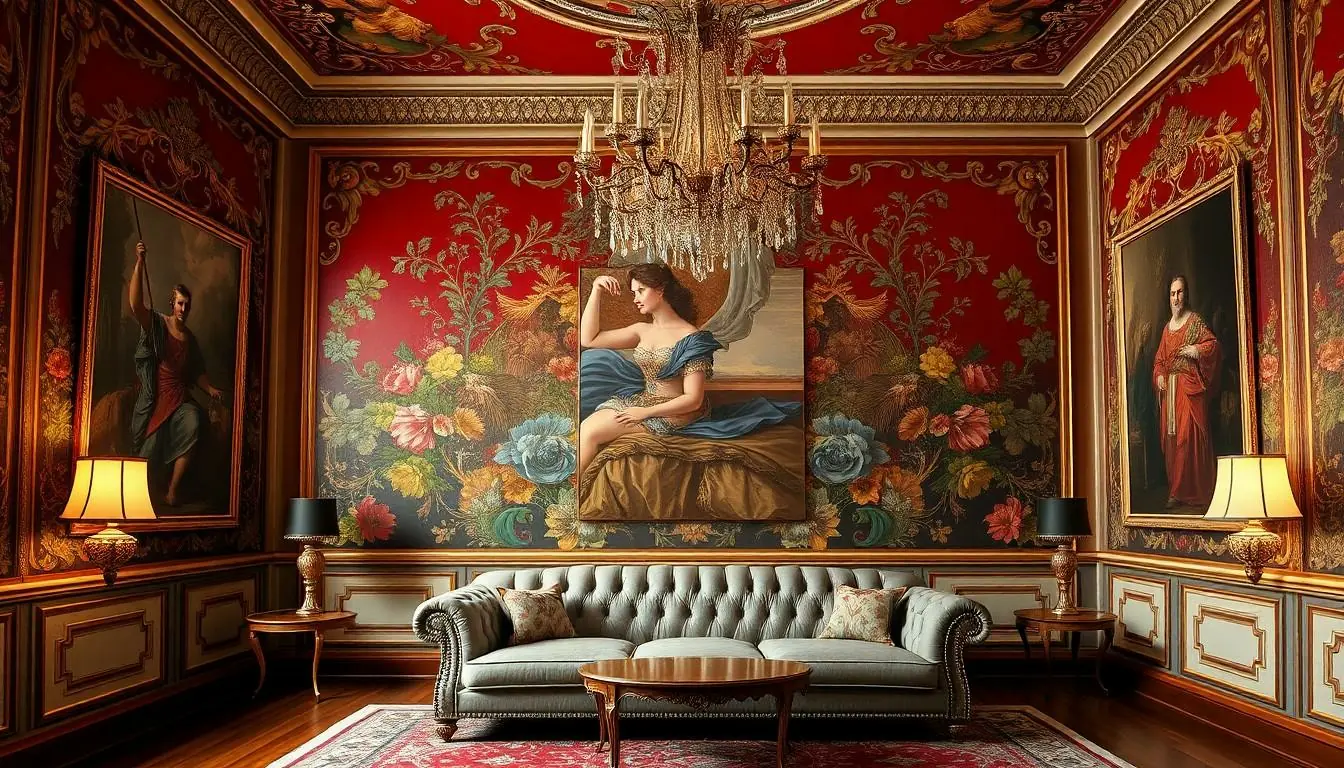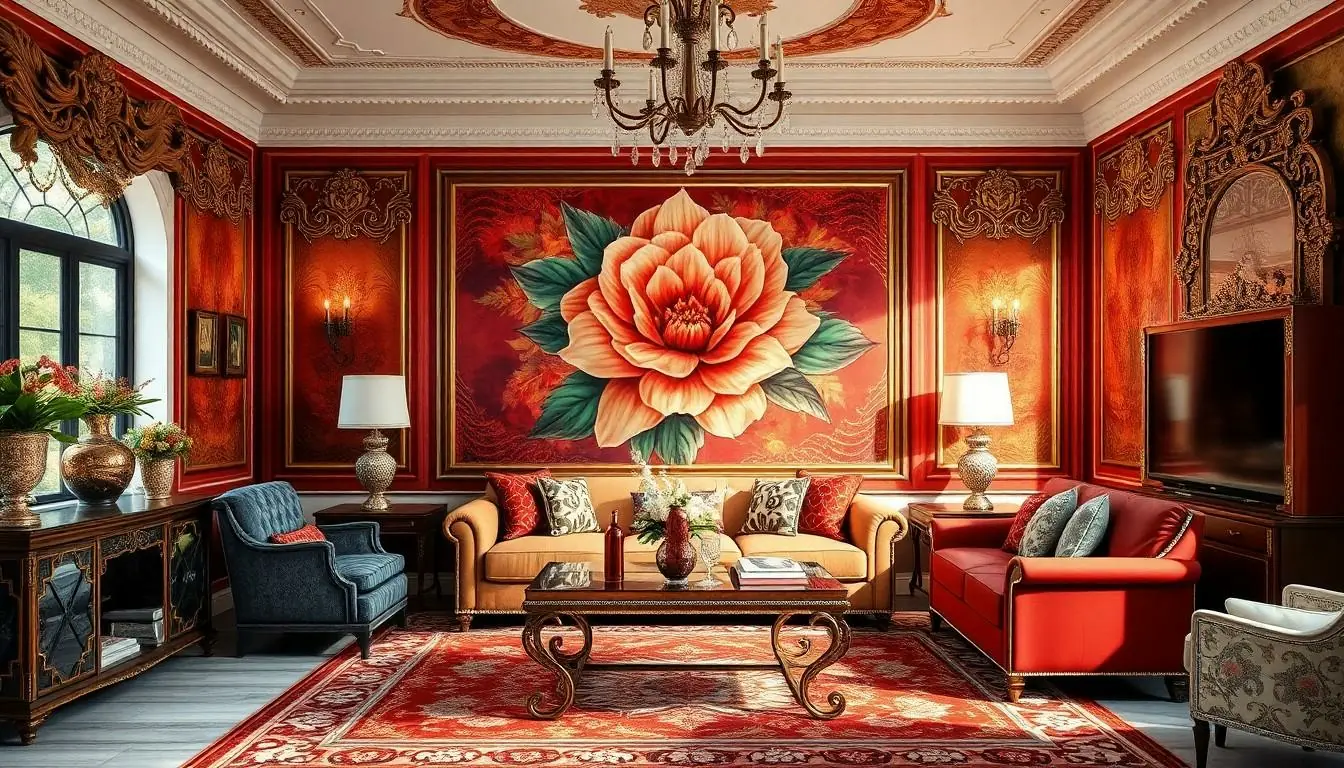Empire painting isn’t just a method; it’s a revolution in the world of home decor. Imagine transforming your walls into stunning masterpieces that make your neighbors green with envy. With a splash of creativity and a dash of finesse, empire painting turns ordinary spaces into extraordinary experiences.
This technique, inspired by the grandeur of empires past, combines rich colors and bold designs to create an atmosphere that’s both regal and inviting. Whether you’re looking to impress guests or just want a cozy nook to binge-watch your favorite series, empire painting has got you covered. So grab your paintbrush and let’s dive into the colorful world of empire painting, where every stroke tells a story and every room becomes a canvas.
Table of Contents
ToggleOverview of Empire Painting
Empire painting represents a distinct approach to home decor that merges historical inspiration with modern aesthetics. This technique draws upon the grandeur of historical empires, integrating rich color palettes and striking designs that evoke a sense of royalty and sophistication. It transforms mundane walls into dramatic backdrops, where artistry meets functionality.
Within this method, designers focus on layers and textures to create depth. Various brush techniques enable the blending of hues, ensuring unique outcomes for each project. Key color choices often include deep reds, vibrant golds, and rich blues, emulating the opulence of past eras.
This style is not merely about painting; it’s a storytelling medium that reflects individual homeowner identities. Creativity shines through with elaborate motifs and patterns that convey personal taste. Artistic freedom thrives in empire painting, allowing room for innovation and expression.
Spaces that feature empire painting often feel inviting, balancing elegance with warmth. Applying this technique can elevate any environment, whether it’s a living room, dining area, or hallway. The versatility of empire painting supports diverse design goals, accommodating both formal and casual settings.
Incorporating accessories that complement the boldness of empire painting enhances the overall aesthetic. Furniture pieces and decor with gold accents or ornate details amplify the regal feel of the space. Carefully selected artwork can also tie together themes of grandeur, further enriching the visual impact.
Empire painting provides an opportunity for homeowners to create standout interiors that captivate and inspire. With each stroke, it invites creativity and individual expression, revealing the unique narrative of the space.
Characteristics of Empire Painting

Empire painting showcases a unique blend of opulence and modernity. It emphasizes rich colors and intricate designs that transport viewers to historical grandeur.
Color Palette
The color palette of empire painting includes deep reds, vibrant golds, and rich blues. These shades evoke a sense of luxury reminiscent of royal aesthetics. Incorporating contrasting tones can enhance the dramatic effects of a space. Earthy neutrals may also balance bold colors, providing depth to the overall design. Different finishes, like matte or gloss, impact the visual appeal, making colors appear more dynamic. When selected thoughtfully, this palette creates a striking atmosphere that energizes any room.
Subject Matter
Subject matter in empire painting often reflects themes of grandeur and nature. Elaborate motifs, like floral patterns, historical figures, or mythical creatures, enrich walls with storytelling. These elements allow for personalization, showcasing the homeowner’s tastes and interests. Scale matters; larger motifs on expansive walls create a commanding presence, while smaller designs add subtle elegance. Historical references and ornamental details contribute to the overall sophistication of the decor, reinforcing the narrative aspect of this artistic technique. Each choice in subject matter enhances the room’s character, intertwining beauty with individuality.
Historical Context
Empire painting draws inspiration from historical empires, with a significant influence from the Napoleonic era. This era’s artistic choices reflect a blend of elegance and opulence, setting trends that still resonate in modern design.
Influence of the Napoleonic Era
The Napoleonic era marked a time of grandeur, characterized by dramatic colors and intricate motifs. Art during this period often featured themes of victory and celebration, establishing a strong visual identity. Rich reds, blues, and golds captured attention and conveyed a sense of power. Interior spaces painted in these hues offered a luxurious atmosphere, transforming homes into representations of status. Classic elements, such as laurel wreaths and classical architecture, became popular in design, reflecting Napoleonic ideals of strength and beauty.
Key Artists and Their Contributions
Influential artists shaped the empire painting movement. Jean-Auguste-Dominique Ingres, known for his neoclassical portraits, contributed to the aesthetic by emphasizing form and detail. His paintings inspired the use of bold colors and precise lines in wall designs. Eugène Delacroix introduced dynamic compositions and emotional expression, leading to the incorporation of lively scenes and characters in decorative schemes. Additionally, the works of François Boucher influenced the whimsical and playfully ornate aspects of empire painting, encouraging elaborate floral patterns and mythological themes. Each artist brought unique ideas, enriching the narrative potential of wall art.
Techniques Used in Empire Painting
Empire painting utilizes specific techniques that enhance the overall visual appeal through meticulous craftsmanship.
Brushwork and Texture
Brushwork techniques create striking textures. Artisans may apply layering to add depth, often using different brush types for varied effects. One technique involves stippling, which provides a textured finish, while broad strokes contribute to bold patterns. Metallic paints enhance the regal quality, reflecting light and enriching color vibrancy. Intricate detailing captures attention, transforming standard wall space into artistic masterpieces. The combination of these techniques showcases artistry while bringing personal expression to each project.
Use of Light and Shadow
Light and shadow play a significant role in empire painting. Artists use contrasting colors to create dramatic effects, enhancing the depth of designs. Strategic placement of lighter shades alongside darker tones brings vibrancy and dimension to motifs. This technique accentuates the intricate details of patterns, inviting viewers to explore textures. Shimmering finishes can mimic the soft glow of candlelight, further elevating the atmosphere. Overall, the interplay of light and shadow not only highlights artwork but also creates a warm and inviting environment.
Notable Works of Empire Painting
Empire painting features several iconic works that showcase its unique style and historical significance. Notable examples include Jean-Auguste-Dominique Ingres’ “La Grande Odalisque,” which combines classical themes with intricate detailing, representing the grandeur associated with the Napoleonic era. This piece highlights the allure of the exotic, prevalent in empire painting.
Eugène Delacroix’s “Liberty Leading the People” serves as another powerful example. Celebrated for its dynamic composition, this artwork captures the spirit of revolution and reflects the emotional depth characteristic of the movement. Vivid colors and bold figures create a sense of movement that resonates with the audience.
François Boucher’s “The Toilet of Venus” exemplifies the whimsical aspects of empire painting. Boucher’s use of delicate florals and mythological references embodies the opulence and charm synonymous with the style. The soft color palette enhances the ethereal quality, drawing viewers into a lush, inviting world.
Among lesser-known works, “The Apotheosis of Homer” by Jean-Auguste-Dominique Ingres stands out. This painting illustrates the importance of ancient culture through its detailed depiction of classical figures, celebrating the heritage that empire painting often seeks to convey.
In addition, tapestry designs from the 19th century frequently adopted empire aesthetics. These pieces often fused luxurious fabrics with grand motifs, reinforcing the narrative quality of empire painting across various mediums. Intricate patterns and rich colors dominated these textiles, showcasing the versatility of the artistic approach within home decor.
Overall, the notable works of empire painting reflect a commitment to elegance, storytelling, and emotional resonance, enriching both historical and contemporary interiors.
Empire painting offers a unique fusion of historical elegance and modern design. Its ability to transform spaces into captivating narratives sets it apart in the world of home decor. By embracing rich colors and intricate motifs, homeowners can express their personal style while creating an inviting atmosphere. The meticulous craftsmanship involved in this technique not only enhances visual appeal but also adds depth and character to any room.
As individuals explore empire painting, they find an opportunity to infuse their homes with stories and artistic flair. This approach to wall art encourages creativity and individuality, making it a compelling choice for those looking to elevate their interior spaces.



